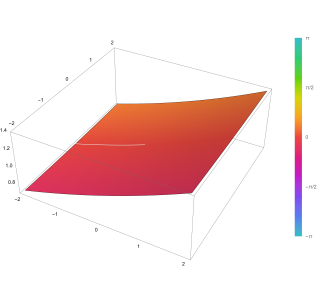
In mathematics, Legendre polynomials, named after Adrien-Marie Legendre (1782), are a system of complete and orthogonal polynomials with a vast number of mathematical properties and numerous applications. They can be defined in many ways, and the various definitions highlight different aspects as well as suggest generalizations and connections to different mathematical structures and physical and numerical applications.

In physical science and mathematics, the Legendre functionsPλ, Qλ and associated Legendre functionsPμ
λ, Qμ
λ, and Legendre functions of the second kind, Qn, are all solutions of Legendre's differential equation. The Legendre polynomials and the associated Legendre polynomials are also solutions of the differential equation in special cases, which, by virtue of being polynomials, have a large number of additional properties, mathematical structure, and applications. For these polynomial solutions, see the separate Wikipedia articles.
In mathematics, the classical orthogonal polynomials are the most widely used orthogonal polynomials: the Hermite polynomials, Laguerre polynomials, Jacobi polynomials.

In mathematics, a generalized hypergeometric series is a power series in which the ratio of successive coefficients indexed by n is a rational function of n. The series, if convergent, defines a generalized hypergeometric function, which may then be defined over a wider domain of the argument by analytic continuation. The generalized hypergeometric series is sometimes just called the hypergeometric series, though this term also sometimes just refers to the Gaussian hypergeometric series. Generalized hypergeometric functions include the (Gaussian) hypergeometric function and the confluent hypergeometric function as special cases, which in turn have many particular special functions as special cases, such as elementary functions, Bessel functions, and the classical orthogonal polynomials.
In mathematics, Rodrigues' formula is a formula for the Legendre polynomials independently introduced by Olinde Rodrigues, Sir James Ivory and Carl Gustav Jacobi. The name "Rodrigues formula" was introduced by Heine in 1878, after Hermite pointed out in 1865 that Rodrigues was the first to discover it. The term is also used to describe similar formulas for other orthogonal polynomials. Askey (2005) describes the history of the Rodrigues formula in detail.
In mathematics, the associated Legendre polynomials are the canonical solutions of the general Legendre equation
In mathematics, Gegenbauer polynomials or ultraspherical polynomialsC(α)
n(x) are orthogonal polynomials on the interval [−1,1] with respect to the weight function (1 − x2)α–1/2. They generalize Legendre polynomials and Chebyshev polynomials, and are special cases of Jacobi polynomials. They are named after Leopold Gegenbauer.
In mathematics, the Hahn polynomials are a family of orthogonal polynomials in the Askey scheme of hypergeometric orthogonal polynomials, introduced by Pafnuty Chebyshev in 1875 and rediscovered by Wolfgang Hahn. The Hahn class is a name for special cases of Hahn polynomials, including Hahn polynomials, Meixner polynomials, Krawtchouk polynomials, and Charlier polynomials. Sometimes the Hahn class is taken to include limiting cases of these polynomials, in which case it also includes the classical orthogonal polynomials.
In mathematics, Racah polynomials are orthogonal polynomials named after Giulio Racah, as their orthogonality relations are equivalent to his orthogonality relations for Racah coefficients.
In mathematics, Stieltjes–Wigert polynomials are a family of basic hypergeometric orthogonal polynomials in the basic Askey scheme, for the weight function

In mathematics, Jacobi polynomials are a class of classical orthogonal polynomials. They are orthogonal with respect to the weight on the interval . The Gegenbauer polynomials, and thus also the Legendre, Zernike and Chebyshev polynomials, are special cases of the Jacobi polynomials.
In mathematics, the continuous Hahn polynomials are a family of orthogonal polynomials in the Askey scheme of hypergeometric orthogonal polynomials. They are defined in terms of generalized hypergeometric functions by
In mathematics, the dual Hahn polynomials are a family of orthogonal polynomials in the Askey scheme of hypergeometric orthogonal polynomials. They are defined on a non-uniform lattice and are defined as
In mathematics, the q-Hahn polynomials are a family of basic hypergeometric orthogonal polynomials in the basic Askey scheme. Roelof Koekoek, Peter A. Lesky, and René F. Swarttouw give a detailed list of their properties.
In mathematics, the Bateman polynomials are a family Fn of orthogonal polynomials introduced by Bateman. The Bateman–Pasternack polynomials are a generalization introduced by Pasternack (1939).
In mathematics, the Mehler–Heine formula introduced by Gustav Ferdinand Mehler and Eduard Heine describes the asymptotic behavior of the Legendre polynomials as the index tends to infinity, near the edges of the support of the weight. There are generalizations to other classical orthogonal polynomials, which are also called the Mehler–Heine formula. The formula complements the Darboux formulae which describe the asymptotics in the interior and outside the support.
In mathematics, the dual q-Krawtchouk polynomials are a family of basic hypergeometric orthogonal polynomials in the basic Askey scheme. Roelof Koekoek, Peter A. Lesky, and René F. Swarttouw give a detailed list of their properties.
In mathematics, the little q-Laguerre polynomialspn(x;a|q) or Wall polynomialsWn(x; b,q) are a family of basic hypergeometric orthogonal polynomials in the basic Askey scheme closely related to a continued fraction studied by Wall (1941). (The term "Wall polynomial" is also used for an unrelated Wall polynomial in the theory of classical groups.) Roelof Koekoek, Peter A. Lesky, and René F. Swarttouw (2010, 14) give a detailed list of their properties.
In mathematics, the continuous q-Legendre polynomials are a family of basic hypergeometric orthogonal polynomials in the basic Askey scheme.Koekoek, Lesky & Swarttouw (2010) give a detailed list of their properties.
In mathematics, the Romanovski polynomials are one of three finite subsets of real orthogonal polynomials discovered by Vsevolod Romanovsky within the context of probability distribution functions in statistics. They form an orthogonal subset of a more general family of little-known Routh polynomials introduced by Edward John Routh in 1884. The term Romanovski polynomials was put forward by Raposo, with reference to the so-called 'pseudo-Jacobi polynomials in Lesky's classification scheme. It seems more consistent to refer to them as Romanovski–Routh polynomials, by analogy with the terms Romanovski–Bessel and Romanovski–Jacobi used by Lesky for two other sets of orthogonal polynomials.








